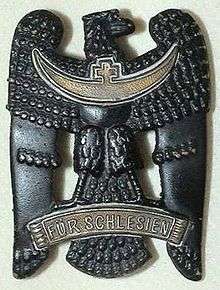Silesian Eagle
| Silesian Eagle Schlesischer Adler | |
|---|---|
 Silesian Eagle 2nd class | |
| Eligibility | Military personnel |
| Awarded for | Awarded to Freikorps Oberland members for service against the Silesian Uprisings |
| Campaign(s) | Silesian Uprisings |
| Status | Obsolete |
| Statistics | |
| Established | 19 June 1919 |
The Silesian Eagle (German language: Schlesischer Adler) was a medal awarded for fighting the Silesian Uprisings as part of the Freikorps Oberland under the Weimar Republic.
Instituted on the 19 of June 1919 by VI. Armee-Korps Generalleutnant Friedrich von Friedeburg, the Silesian Eagle declined itself in two classes, 2nd class for three months of service and 1st class for 6 months of service and could be adorned with oak leaves, swords, or both. This medal was one of the few Freikorps awards that were allowed to be worn on uniforms during the Third Reich after the 1935 ban on unofficial medals. However, the swords, and oak leaves, denoting additional bravery, merit or service were banned, but despite interdictions, many veterans continued wearing them in active military service with the Third Reich.[1][2]
References
- ↑ "Axis History Factbook: Silesian Eagle". Axis History Factbook. Retrieved 10 January 2011.
- ↑ "Silesian Eagle First class". Orders and Medals Society of America. Retrieved 10 January 2011.